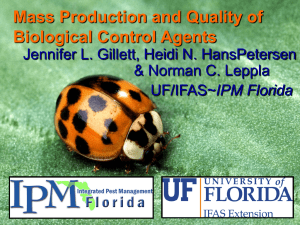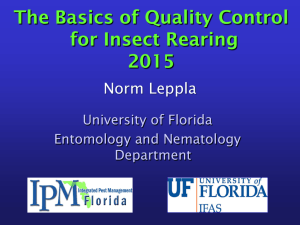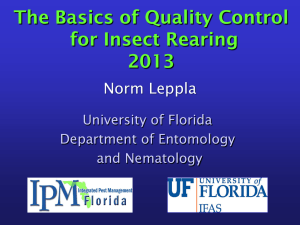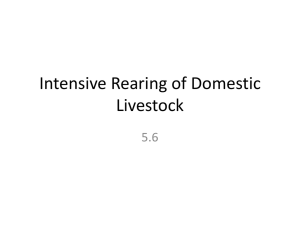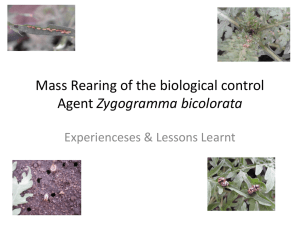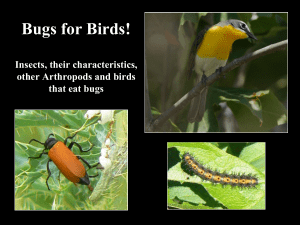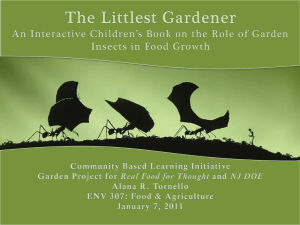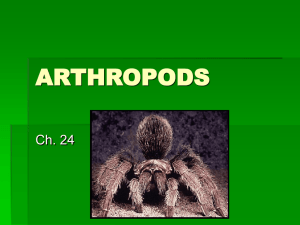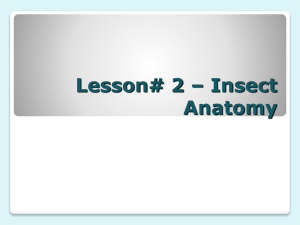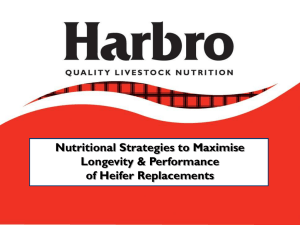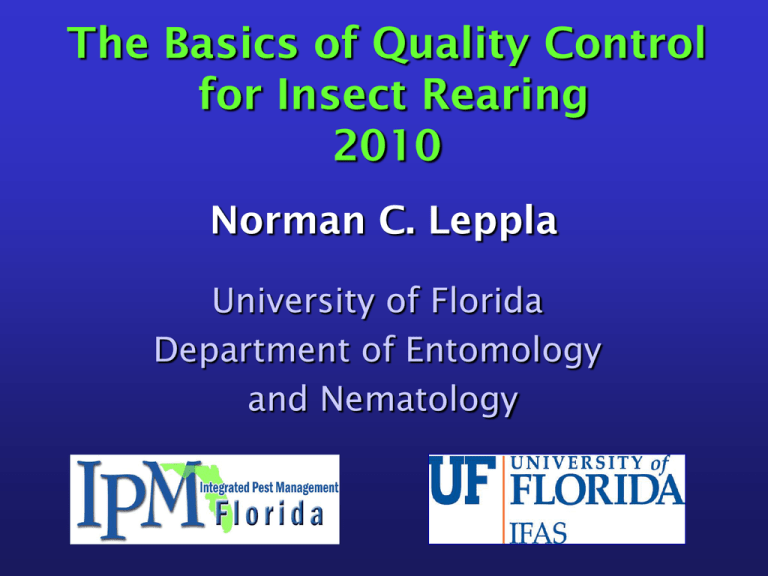
The Basics of Quality Control
for Insect Rearing
2010
Norman C. Leppla
University of Florida
Department of Entomology
and Nematology
Leppla’s Career in
Insect Rearing
• University of Arizona- Insect rearing
research, 2 years
• USDA, ARS- Insectary management
Florida & Texas, 17 years
• USDA, APHIS- Methods development,
Washington DC & international, 7 years
• University of Florida- Integrated pest
management & BC, 13 years
Countries of Workshop Students
Educational
Background
Entomology
Agronomy
PhD
MS
Plant Health
BS
High School
0
On the Job
5
10
Number of responses
15
Educational Background
2010 Class
Learning How to Rear High
Quality Insects
• Apprentice in an insectary
• Network with other professionals
• Literature plus trial-and-error
• Visit other insectaries
• Reviews by experts
• Education and Training programs
Insectary
Manager
Network
Anyone associated with the mass
rearing of insects
Contact Person: Travis Wood
United Industries Corporation
Insect Diet & Rearing
Research, LLC
• Rearing news
• Research
• Consultation
• Educational programs
• Quality control
• Custom workshops
http://www.insectdiets.com
Maintaining the Quality
of Colonized Insects
• Collection of appropriate biotypes
• Colonization and strain development
• Rearing proficiency
• Colony management
• Optimization
• Strain replacement
I. Introduction
II. Colony Establishment and
Maintenance
II. A. Purposes for Rearing Insects
II. B. Types of Insect Rearing Systems
II. C. Options for Colonizing Insects
II. D. Maintaining the Quality of
Colonized Insects
II. A. Purposes for Rearing Insects
White witch,
Thysania
agrippina
(Lepidoptera:
Noctuidae
II. B. Types of Insect
Rearing Systems
Painted Lady
Monarch
Small Scale Rearing: Butterflies
Insect Rearing Facilities
Diet Preparation Building
General Rearing Building
State-of-the-Art Rearing Rooms
Medium-Scale Rearing:
Lepidoptera
Cabbage Looper, Trichoplusia ni
Corn Earworm,
Helicoverpa zea
USDA, ARS Rearing
Keith Halein
Clarence Green
Jack Rye
Bill Fisher
USDA, ARS Rearing
Fred Adams
Fred Adams
Steve Carlyle
Annie Lorie
Insect rearing is never a
boring task; insects are
always doing something
interesting and pose new
challenges all the time
Punky
Rogers
USDA, ARS
Rearing
Mass Rearing: Medfly
El Pino, Guatemala
Capacity of 3.5 billion sterile
male pupae per week
Metapa, Mexico
Honolulu, Hawaii
Nori Tanaka
II. C. Options for Colonizing
Insects
Peter Ebling
Insect Producer Database Mgr.
Great Lakes Forestry Centre
1219 Queen St. East
Sault Ste. Marie, ON P6A 2E5
peter.ebling@nrcan.gc.ca
(705) 541-5517
• World-wide listing,
35 insect & 21
nematode orders
• Data submitted by
sources
• Searchable
database
• Expand clients
• Adopt-a-colony
http://www.insect.glfc.cfs.nrcan.gc.ca
Field Collecting
Cabbage Loopers
Continuous Improvement of
Insect Rearing Capability
II. D. Maintaining the Quality
of Colonized Insects
III. Monitoring Quality
III. A. Quality Control Criteria and
Standardized Tests
III. B. Sampling for Consistent
Quality
III. C. Production, Process and
Product Control
III. A. Quality Control Criteria
and Standardized Tests
• Quantity- Number of Pupae or Adults
• Size- Weight of Pupae
• Fecundity- Oviposition and Egg Hatch
• Rate of Development-Synchronization
• Adult Behavior-Flight, Longevity
• Field Performance- Achieve Purpose
Specifications- Requirements for
a product or service
Standards- The level of quality at
which a specification is written
III. B. Sampling for
Consistent Quality
Count = Measurement = N
Mean = Sum/Number of Counts = X
Variance = Sum of (N – X)2 / n-1 =
Standard Deviation = Square Root of
2
2=
SD
III. C. Production, Process
and Product Control
IV. Evaluation and Management
IV. A. Structured Diagnostic
Procedures
IV. B. Quality Control versus
Methods Improvement
IV. C. Periodic Review versus
Crisis Review
IV. A. Structured Diagnostic
Procedures
IV. B. Quality Control versus
Methods Improvement
Quality Control
• Monitor indicator variables
• Evaluate multiple variables
• Troubleshoot using QC data
• Conduct evaluations rapidly
• Goal is to restore stable production
Methods Improvement
• Conduct evaluations methodically
• Test one variable at a time
• Use controlled experiments
• Test results in the production system
• Goal is to optimize production
Improving Male Fruit Fly
Performance
Abiotic Environment
• Holding Cages
• Handling for Release
Biotic Environment
• Juvenile hormone
• Nutrients (sucrose)
• Semiochemicals
Olivefly Methods Improvement
FAO/IAEA Entomology Unit
Seibersdorf, Austria - 2009
Eggs hatched
Eggs/Cage
Eggs laid
Sex ratio male:female
Eggs Hatched
Total eggs laid
Eggs laid
Number of females
Eggs hatched
Total eggs laid
Eggs laid
Number of males
Olivefly Methods Improvement
IV. C. Periodic Review
versus Crisis Review
•
•
•
•
Terms of reference • Report
Preparation
• Feedback
Seek to understand • Reflect
Clarify
V. Guidelines for Quality
Systems
IOBC
Global Quality Control
Programs
• Individual Companies
Customers
• International Standards
ISO 9000
ASTM International
IOBC Guidelines
• The Marketplace
Quality Products
International Organization
for Biological Control
to facilitate and advance
cost-effective rearing of
high quality insects and
other arthropods in
support of biological
control and integrated
pest management
http://www.amrqc.org
Workshops of the IOBC,
WGQC (AMRQC)
1982 Gainesville, Florida
1984 Wadenswil, Switzerland
1986 Guatemala City, Guatemala
1988 Vancouver, Canada
1991 Wageningen, Netherlands
1992 Horsholm, Denmark
1993 Rimini, Italy
1995 Santa Barbara, California
1998 Cali, Colombia
2003 Montpellier, France
2007 Montreal, Canada
2010 Vienna, Austria
E. F. Boller and D. L. Chambers
E. F. Boller and D. L. Chambers
C. 0. Calkins
C. 0. Calkins
F. Bigler and J. C. van Lenteren
F. Bigler
M. Benuzzi and N. C. Leppla
R. F. Luck and N. C. Leppla
N. C. Leppla and T. R. Ashley
P. De Clercq, S. Grenier and
N. C. Leppla
S. Grenier and C. S. Glenister
P. De Clercq and T. A. Coudron
VI. Total Quality Management
Generic Guidelines for
Quality Systems
• Policy, Planning and Administration
• Design Assurance and Change Control
• Control of Purchased Materials
• Production Quality Control
• User Contact and Field Performance
• Corrective Action
• Employees- Select, Train and Motivate
Total Quality
Management
in Insect
Rearing
Insect Pest
Control (IPC)
http://www-naweb.iaea.org/nafa/ipc/public/ipc-model-plansterile-insect-technique.html
Leppla’s Insect Rearing Quality
Control References
• Leppla, N. C. 2009. The basics of quality control
for insect rearing. In Principles and
Procedures for Rearing Quality Insects.
Mississippi State University.
• Leppla, N. C. 2004, 2008. Rearing of Insects.
Encyclopedia of Entomology.
• Leppla, N. C. 2003. Guidelines for quality control
of commercially produced natural enemies. In
Quality Control and Production of Biological
Control Agents, Theory and Testing Proc.
• Leppla, N. C. 2002, 2009. Rearing of Insects.
Encyclopedia of Insects.
For more information or a copy of
this presentation please visit:
http://ipm.ifas.ufl.edu
Extension Resources, Presentations

